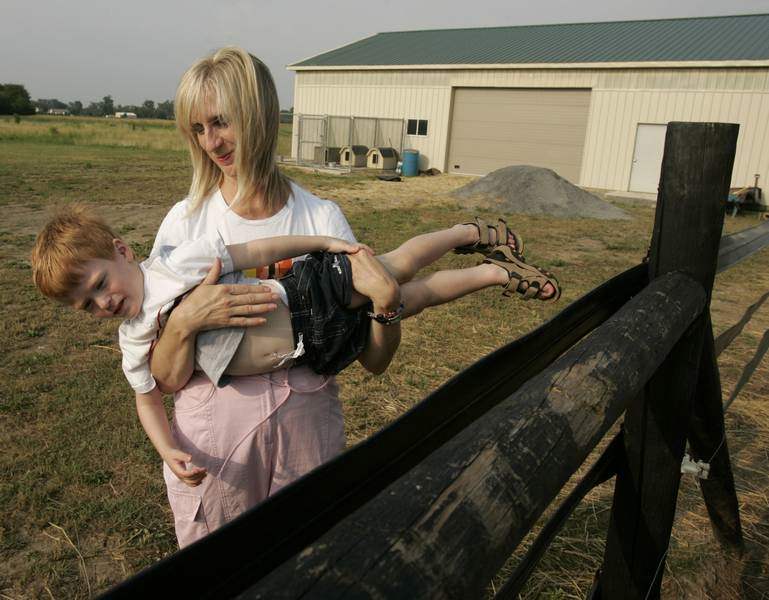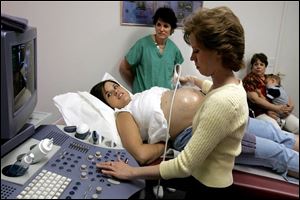
30 years after landmark court case, technology reshapes abortion debate
10/2/2005
Cheryl Herr holds son Thomas, 3, at their Bowling Green home. The Herr twins, Thomas and Mary Grace, were born at 26 weeks and were aided by advances in medical technology.
Sandra Day O'Connor saw it coming.
In 1983, only a decade after the U.S. Supreme Court's landmark Roe vs. Wade ruling that legalized abortion, she worried about cracks in the legal foundation set up by Roe.
Justice O'Connor said Roe was "on a collision course with itself" as medical technology pushed down the age of fetal viability. Now Justice O'Connor has announced her retirement, and her colleague Chief Justice William Rehnquist has died. Congress easily approved John Roberts as the new chief justice Thursday and soon will debate President Bush's pick to replace Justice O'Connor. Depending on who is selected, it could tip the balance on the Supreme Court and either maintain the status quo on abortion law or allow more restrictions.
The new court balance could be revealed relatively soon. The court is expected to hear arguments in an abortion case this spring - the federal Partial-Birth Abortion Act - which, if it stands, would institute a national ban on a type of late-term abortion.
But as Congress and the public again debate the abortion issue, it's also clear that the fetus in the America of 2005 differs from the one talked about in 1973, when Roe was decided.

Mary Grace Herr, 3, plays on the trampoline which her sister Megan Herr, 11. Mary Grace and her twin brother, Thomas, were born more than three months early at Mercy Children's Hospital.
In 1973, little babies like Mary Grace Herr did not grow up to be little girls.
She and her twin brother, Thomas, were born in Toledo in 2001 at 26 weeks, more than three months early. The tiny babies each weighed a little under 2 pounds. In 1973, they likely would have died. And yet, on a warm summer afternoon, her father, Mark Herr, smiles as he watches 3-year-old Mary Grace dash toward the family's two horses on their property in rural Bowling Green screaming, "Rocket, Rocket!"
"She walks a little funny, but they told us she wouldn't even walk at all," Mr. Herr says as he watches his daughter shriek with excitement as she tries to pet Rocket.
In 1973, expectant mothers didn't look at photos of babies in their womb.
In 2005, mothers like Jillian Meyer of Waterville can watch their babies move around inside the womb in three dimensions. Mrs. Meyer stares at a view screen and watches as her twin girls appear in a three-dimensional, computer-generated image.

Cheryl Herr holds son Thomas, 3, at their Bowling Green home. The Herr twins, Thomas and Mary Grace, were born at 26 weeks and were aided by advances in medical technology.
"Oh, my gosh. They're so cute ... You can really see that they're real," she says as she watches the images of her tiny, 27-week-old babies.
In 1973, Benjamin Bonser would have died soon after birth.
A benign tumor the size of an orange was pressing against his neck and would have cut off his air supply soon after he was delivered.
Instead, a fetal surgeon at the University of Michigan inserted an artificial airway into Benjamin, delivered the baby four weeks early, and then removed the tumor. Today, Benjamin is expected to lead a normal life.
"We were so lucky that they have the technology to even do it," said his mother, Sharon Kramer of Clarkston, Mich.
Arthur Caplan, a bioethicist at the University of Pennsylvania, sees examples like this and thinks they have ripple effects on the public's attitudes toward abortion.
"It is absolutely reshaping the abortion debate," he says. "You've literally made it from an entity that isn't yet a person to a patient. You take all this together and you're starting to get a shift in the moral status of a fetus. I'm not saying I'd endorse it, but absolutely there's been a change in what we know."
It was a compromise.
When the U.S. Supreme Court in 1973 said that a woman's right to abortion was protected under her right to privacy, it did allow some regulation of abortion. The court has consistently said that one main issue that must be considered is viability. Though viability does not prevent abortion, it does open the door to the states by allowing them to pass restrictions on abortion if they choose.

Jillian Meyer has a 3D-imaging ultrasound performed by Donna Schoch as her mother, Kim Hertzfeld, center, and her mother-in-law Karen Meyer, holding Jillian Meyer's son, Trey, look on. Ms. Meyer later gave birth to twins Kamryn and Mikayla.
The court said to be considered viable, a fetus had to have the capability to live outside the mother's womb, with medical aid if needed.
"One of the unintended consequences of Roe vs. Wade is it stakes everything to viability. Well, viability moves. It's changed," said Jeffrey Kahn, director of the Center for Bioethics at the University of Minnesota. "In 1973, viability was a whole lot later. It's been pushed back."
In 1973, viability was around 28 weeks. Today it's around 24 weeks, with some rare examples of infants surviving at 22 or 23 weeks.
"When I started, the barrier was 28 weeks. That was 30 years ago, and you would have been considered insane to treat a baby under 28 weeks," says Dr. Richard Martin, director of Cleveland's Rainbow Babies and Children's Hospital, one of the nation's top pediatric facilities.
Pro-choice supporters say even though viability has been lowered, it's still a moot issue because of the reality of when abortions occur.
For example, almost all abortions in the United States - there are about 1.29 million annually - are not performed near or above the age of viability. The federal Centers for Disease Control and Prevention reports in their most recent data from 2001 [which excludes three states, including California] that 88 percent of all abortions are performed under 13 weeks gestation, with only 1.4 percent - or about 18,200 abortions - at 21 weeks and above.
The CDC does not break down abortions by individual week. However, the Alan Guttmacher Institute of New York did a survey on abortion nationwide in the early 1990s. From its report, the institute said that 1.5 million abortions were performed in 1992. It estimated about 10,000 abortions were done at weeks 21-22; 5,000 at 23-24 weeks; 850 at 25-26 weeks, and about 320 at 26 weeks or greater.
Dr. Martin said though he's saving infants at younger ages, he worries the public gets an inaccurate idea of what's possible. For example, though 24 weeks is considered viable by many doctors, only about half of babies born this early survive. In those who do, half have serious complications, such as mental retardation, while the other half varies from those with moderate problems to normal babies.
Lying on her back in the office of Sylvania Ultrasound Institute, Jillian Meyer, pregnant with twins, watches as the technician slides the ultrasound wand over her belly.
"See, there's Baby A," says the technician. "Here's the thigh bone."
Jillian's mother, Kim Hertzfeld, stands by her daughter and watches the images of her new grandchildren come into view.

Twins Kamryn, left, and Mikayla Meyer are hlep by their mother, Jillian Meyer. Advanced ultrasound technology provided Ms. Meyer with clear images of her babies as early as 27 weeks.
These are not the grainy black and white images most mothers and fathers have seen - the type expectant parents proudly post on their refrigerator or send to families with a circled blob on which they write "new baby." No, these pictures look like, well, little babies. Arms, heads, legs are all visible to the layperson.
"It's sure a lot more stuff than 23 years ago," Mrs. Hertzfeld said, recalling the images she had of Jillian and Jillian's sister when they were babies. "It's plain as day now."
Some ethicists and physicians argue that advanced ultrasound like this, though not affecting viability of a fetus, is influencing the abortion debate.
Mark Bliton, a bioethicist at Vanderbilt University Medical Center in Nashville, says it's all about the pictures.
"There's something about our culture and something about us as human beings that when we see something, it starts to have a different connotation," he said.
This doesn't mean powerful images like this influence women to not have an abortion, according to Dr. William Suarez, a pediatric cardiologist in Toledo. Dr. Suarez points out that just as the new technology can show photos of a baby at a very early age, they can also find defects at an early age.
This then presents parents with a choice, he says: Should they continue with the pregnancy or abort the fetus now to avoid a baby with health defects?
"Fetal ultrasound is so much better today," he said.
Dr. Suarez said he can look at fetal ultrasounds done at 14 or 15 weeks that will determine whether a fetus has a heart abnormality, a vast improvement over the 1970s when a heart defect wasn't detected until birth.
"Clearly, technology has made fetal diagnosis really good," he said.
At the same time newer ultrasound has improved diagnosis of fetal defects, Dr. Suarez said the ability to treat those defects also has gotten better. He points to one relatively common heart defect, known as hypoplastic left heart syndrome, which often was fatal 30 years ago.
But today, "when a parent asks us what the chances [their] baby will survive are, they don't hear 50 percent. They hear 70 to 90 percent," he said. "So technology may end up reducing some abortions."
The surgeries Dr. Suarez are referring to are done after a baby is born. But, he says, in the future doctors will be able to treat even more defects in fetuses - before they're born.
An hour north of Toledo, the future has already arrived.
Dr. George Mychaliska was a young medical student at the University of California-San Francisco when he first heard one of his professors talk about fetal surgery. It was the early 1980s and doctors were theorizing that they might be able to save some infants with birth defects if they were able to detect them early and operate on them while the babies still were in their mothers' wombs.
He decided to specialize in pediatric surgery with the hope that the research would pan out.
"I thought, 'These disorders are happening in a developing fetus and maybe we can make an impact ... that's a very powerful notion,' " he recalled recently as he sat in his office at the University of Michigan.
Behind him on a bookshelf is a textbook, The Unborn Patient. On his computer's desktop is a digital photo of his twins.
At first, progress was slow and the research disappointing, said Dr. Mychaliska, now director of the University of Michigan's fetal surgery program at that institution's C.S. Mott Children's Hospital. But doctors have made progress, and today a handful of medical centers, including those in Cincinnati and Ann Arbor, are doing medical surgeries on fetuses.
Saving Benjamin Bonser was a powerful reminder of how much progress has been made, he said.
"It was a very dramatic experience. I did think about" how far medical treatment had progressed. "That child will lead a totally normal life now. It doesn't get any better than that."
Dr. Mychaliska predicts a "paradigm shift in the near future" regarding how doctors and patients view once untreatable diseases as medical technology continues to improve.
He points out cutting edge research into the use of "cellular transplantation" into tiny fetuses to prevent defects like sickle cell anemia, a condition in which the body produces abnormally shaped red blood cells and can lead to tissue damage. Dr. Mychaliska said one theory is that if a fetus is screened and found to have a defect like sickle cell anemia, inserting donor cells from someone with normal red blood cells might prevent the fetus from developing the disease. This procedure would likely have to be done under 15 weeks gestation, before the fetus' own immune system has fully developed.
Dr. Richard Fulroth remembers sitting down and having a conversation with Mark and Cheryl Herr, parents of the Herr twins, Mary Grace and Thomas.
He'd already "intubated" Mary Grace, who was struggling to survive, four or five times and he needed guidance from the Herrs.
"I remember sitting down and asking them, 'Where do we go now?' " said Dr. Fulroth, director of neonatology at Mercy Children's Hospital in Toledo.
"They told me God wanted us to have both," he said.
Fortunately, for the Herrs, God had a little more help in 2001 than he would in the 1970s when Dr. Fulroth first started trying to save premature babies.
Back then, he was a young medical resident in Cleveland. He often would climb into a station wagon ambulance, and rush to area hospitals to care for a premature baby.
He would find the premature baby, if it was still alive, surrounded by discarded medical supplies such as intravenous needles, that nurses and doctors had tried to insert into the tiny infant. He would quickly do his best to stabilize the infant, put it into a crude ventilator in the back of a station wagon ambulance and rush it back to his hospital. Usually, his attempts to save the baby failed.
But when the Herr babies came early, he was far better prepared than in those early days.
He and his team ordered head ultrasounds to look for bleeding in the brain, one of the most common killers of premature infants, in order to fine-tune the delivery of medication. In the 1970s, doctors could only guess - "We used our gut feeling" - about what was going on inside the baby's brain.
The Herr twins were hooked to ventilators to help them breathe. The ventilators could detect a tiny exhaled breath of air from the infants and quickly, and gently, force a tiny puff of air back into their lungs. These ventilators alone "have made the difference between babies dying and living," Dr. Fulroth explains. In the 1970s, ventilators were crude and often caused more harm than good because they weren't tailored to care for infants.
Both twins were given an artificial substance called "surfactant" which mimics a naturally occurring substance in a normal baby's lungs. Without surfactant, a baby's lungs can collapse and breathing can become impossible. Surfactant, first widely used in the 1990s, was another huge advance. With it, both Herr twins were able to breathe relatively normally.
Then there was surgery. Operating on an infant about the size of a pop can is difficult to say the least. In the 1970s, instruments were just too big. For the Herr babies, tiny cutting, slicing, and sewing instruments enabled doctors to fix a common heart defect found in premature babies.
So where do all these medical advances lead? Just because technology has allowed premature babies to survive more today than in the past doesn't automatically make the abortion issue easier or harder to decide, argue those on both sides of the issue.
Dr. Mia Doron, a neonatologist at the University of North Carolina in Chapel Hill, argues that what technology has done is force people to begin asking more questions, though not necessarily providing any better answers.
"Sandra Day O'Connor's quote, about ... [Roe vs. Wade] being on a collision course with technology - she's right. That's exactly what's happening," said Dr. Doron, author of Preemies: The Essential Guide for Parents.
Nearly four years after birth of the Herr babies, Dr. Fulroth said technology has improved even more. His hospital is set to open an advanced, 30-bed neonatal intensive care unit that has, among other features, decibel monitors to keep sounds below a certain level. Loud sounds can trigger a rise in blood pressure in premature babies, a potentially deadly event.
Dr. Fulroth said he's thrilled with advances like this improving care for babies. But he said he often asks himself: "Is technology taking us with it" in the debate over what to do or not do for a fetus or infant.
"The debate is, are we saving babies that will end up in an institution? Yes," he said. "We're also saving babies that will smile and wave and get on the bus to go to kindergarten."
Contact Luke Shockman at: lshockman@theblade.com or 419-724-6084.